according to How does one measure the power factor? I can measure the power factor (cos phi) by comparing the zero point crossing of Voltage and Current. This is clear.
The problem I have is what if I can't tell exactly when the zero crossing is? My idea is to measure the cos phi with an arduino using a very simple circuit.
Basically I want to use Resistors to break down the voltage to +- 5, then use a diode to have only the positive waves. With this, I can sample the voltage using the analog input of the Arduino, let's say at least 2 faster than 50 Hz. The arduino nano for example has a clock speed of 16 MHz :-) (Nyqvist).
Now, with the current I plan to do the same. Take a cheap linear current transformer and convert to voltage using resistor, so I will get only + 5V max.
I will calculate resistors and transformers so that for the max V and A I will get the range I need, and I can also secure my Arduino with over voltage security.
I don't need to measure U and A exactly. I don't need this values with precision, that's why the usage of cheap elements and simple approach might be enough.
What I need is to calculate the phase. Please take a look at the picture: 
Let's asume 1. I can measure Current and Voltage as only positive waves from 0 to 5V max 2. I sample fast enough 3. I can detect the point where they go from zero to some value (I will make an error here as well...) 4. There is some error on the measurement (magnitude) 5. I can calculate dt between V and A. With it, I can calculate cos phi
My question is: is this possible/ feasible? Is the error I make in 3 big enough to make this cos phi measurement impractical? How can I calculate this error?
Thanks a lot